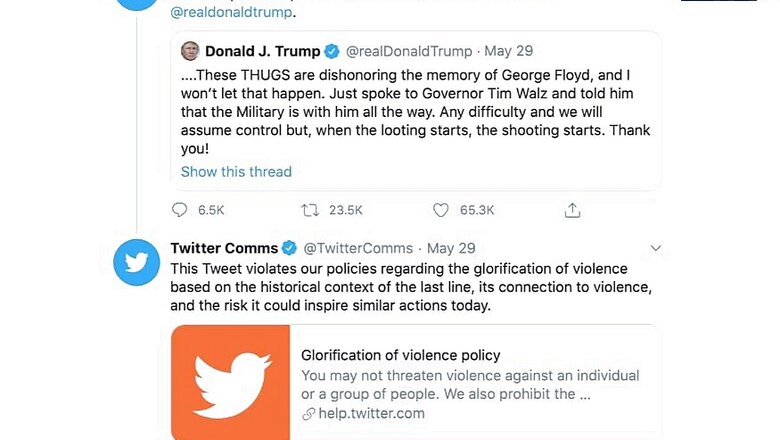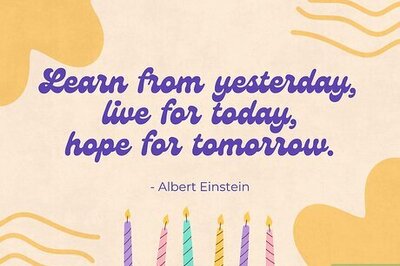
views
In the eyes of many, US President Donald Trump’s tweets have been indicative of a much larger problem. Something that Twitter chose to ignore over the years. This isn’t the first time Trump has used Twitter to write something inflammatory or share an opinion that can diplomatically be labeled as controversial. And more often than not, it went ignored, at least in the sense that Twitter didn’t bother to do anything about it. So much so, that it surprised no one now. Which is exactly why everyone is taking notice when Twitter decided to fact-check Trump on some of his tweets (the mail-in ballots one stands out) and actually put a public interest notice on a tweet which Twitter said, “violated the Twitter rules about glorifying violence”. Trump’s tweet came after the absolutely shocking video of 46-year-old Minnesota resident George Floyd’s death led to angry reactions in many American cities.
Floyd was being taken in for questioning for allegedly buying food items using fake currency, according to The Washington Post. During the subsequent questioning, video footage recorded by onlookers shows one of the officers pinning down Floyd on the ground, with his knee on his neck. In one of the videos, Floyd can be seen pleading with the officer, repeatedly saying he cannot breathe. The knee remained on the neck for 8 minutes and 28 seconds, according to media reports. The nation reacted angrily. The world reacted angrily. Rightly so.
In the tweet that Twitter took semi-hid behind a public notice, Trump wrote the line, “when the looting starts, the shooting starts.” There’s a historical significance attached to that phrase. In December 1967, violence had broken out during the Republican National Convention in Miami. The then Miami Police Chief Walter Headley had reportedly said “when the looting starts, the shooting starts”. He introduced a “get tough” policing policy that involved the use of shotguns, dogs, and aggressive “stop and frisk” tactics in black neighborhoods in an attempt to reduce the crime rate. The New York Times quoted him at the time, saying, “We don’t mind being accused of police brutality.”
Before you paint Twitter as the savior of all things humanity, the good fighting the evil and what not, let us drive down the memory lane to see how Twitter has chosen to deploy a completely different policy to such tweets by “world leaders”. In early 2018, Twitter had taken pains to explain that “Blocking a world leader from Twitter or removing their controversial Tweets would hide important information people should be able to see and debate. It would also not silence that leader, but it would certainly hamper necessary discussion around their words and actions.” It had also cited global, public conversation. And followed through on it steadfastly, till now. Trump, in the meantime, has pretty much gone to war with anyone who has disagreed with him, using Twitter as his megaphone. He has mocked people, he has shared what can be lightly put as his version of facts, he has attacked individuals and establishments and pretty much gauged public opinion with his tweets. The thing is, you cannot probably hold that against Trump, or any world leader—Twitter gave him that platform and he used it. Twitter has so-called community and content policies for the rest of us but decided that world leaders are above the law. Good then. What is the point of crying over spilt milk? The milk that you spilled in the first place. And go into a crazy PR frenzy to be seen doing course correction?
Twitter had the right to, and Twitter had the obligation to enforce the terms of service against any user violating them. It did not.
Is this the first time #BlackLivesMatter really mattered to Twitter? It seems to be. The global social media network has #BlackLivesMatter on its profile now, and the otherwise blue Twitter bird logo is now black.
In April 2018, a disturbing video of a police officer punching a black student of the Harvard University made rounds on social media. In April as well, a black man with a history of mental illness had a run-in with law enforcement in Salt Lake City and was killed in the subsequent shooting. In May, an unarmed black man was shot in California by the police. In July, a 17-year old black student was shot by the police in East Pittsburgh. These are just some examples. #BlackLivesMatter isn’t new. Neither is the law enforcement bias against black people. Twitter didn't make much noise about this shocking reality till now.
According to advocacy group Mapping Police Violence, even they make up only 13 percent of the US population, Black Americans are two-and-a-half times as likely as white Americans to be killed by the police. The states of California, Texas and Florida, incidentally the three largest states in the US, have recorded the highest number of killings of black Americans by law enforcement. The data is scary. It has been this way for quite a while now. But till now, Twitter didn’t really bother. Did it?
It seems Twitter finally grew a pair when they clarified why it put up a public interest notice on Trump’s tweet. “This Tweet violates our policies regarding the glorification of violence based on the historical context of the last line, its connection to violence, and the risk it could inspire similar actions today,” the social network said, and gave us a helpful link that lists its content policies. We know already, Jack.
Did any of you read that so-called public interest notice that was plastered over Trump’s tweet which Twitter claims has historical context? It reads, “This Tweet violated Twitter Rules about glorifying violence. However, Twitter has determined that it may be in the public’s interest for the Tweet to remain accessible.” There you go. Click on “view” next to it and read exactly what President Trump wrote.
Facebook CEO Mark Zuckerberg has been more forthcoming about the tough spot that social networks find themselves in at this juncture. “I know many people are upset that we've left the President's posts up, but our position is that we should enable as much expression as possible unless it will cause imminent risk of specific harms or dangers spelled out in clear policies,” he says, while making it clear that personally, he has a visceral negative reaction to this kind of divisive and inflammatory rhetoric. He further clarifies, “Although the post had a troubling historical reference, we decided to leave it up because the National Guard references meant we read it as a warning about state action, and we think people need to know if the government is planning to deploy force. Our policy around incitement of violence allows discussion around state use of force, although I think today's situation raises important questions about what potential limits of that discussion should be.” Zuckerberg may have to think hard and fast. The thing with Facebook is, we know where we stand. No cosmetic PR stunts, at least so far.
Perhaps what Twitter forgot all these years is the fact that any individual leveraging Twitter as a platform to get their messaging across, is using something that isn’t owned by the government. And that must come with its own policies and guidelines. They haven’t really stopped or gone easy on other users who may have violated the policies. “Hey @Twitter, shut down all White Supremacists’ pages immediately. You are a private platform. You say that #BlackLivesMatter, prove it. The dollars you get from allowing racism to thrive on your platform are not more valuable than the lives that will be saved by taking action?” says Brian Sims. He is a civil rights attorney as well and has 89.6k followers on Twitter.
The uncomfortable truth is that when social media companies try to do PR stunts to get some goodwill, it becomes very easy to see-through the antics almost instantly. All these cosmetic crackdowns on content policy violations aren’t really fooling anyone. You are not getting any plaudits for this. Unless it is a start on clamping down the platform of outrage that you provided in the first place. Or is it just too late for everything?
















Comments
0 comment